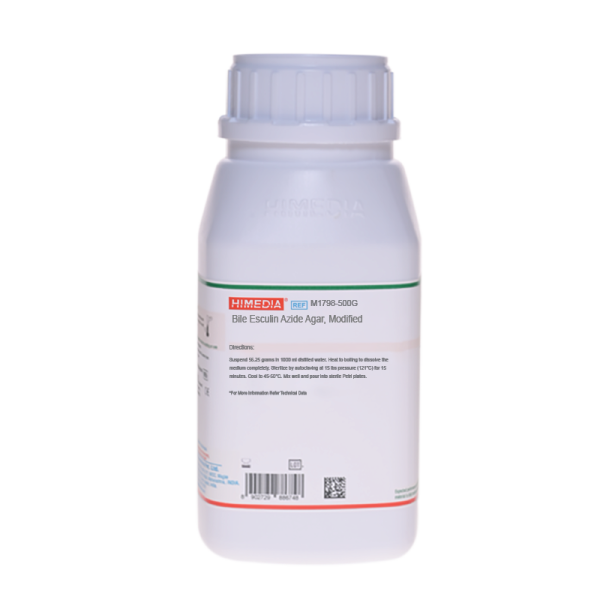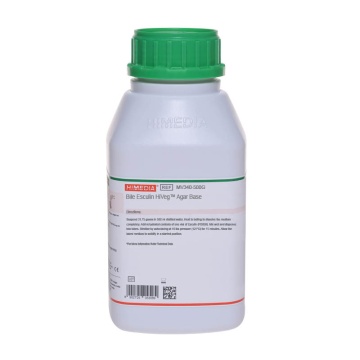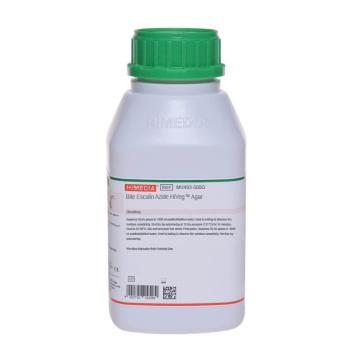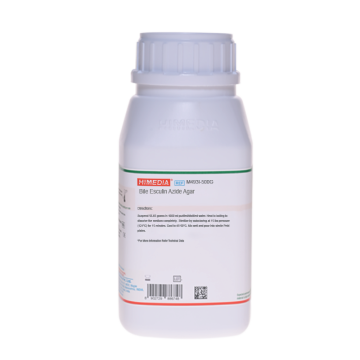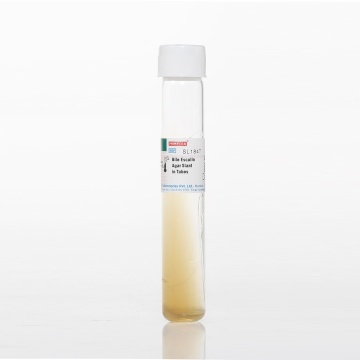 Your enquiry has been submitted
Your enquiry has been submitted
Bile Esculin Azide Agar, Modified
Bile Esculin Azide Agar, Modified is used for rapid, selective detection and enumeration of Enterococci and Group D Streptococci.
Composition**
| Ingredients | Gms / Litre |
|---|---|
| Casein enzymic hydrolysate | 17.000 |
| Peptic digest of animal tissue | 3.000 |
| Yeast extract | 5.000 |
| Oxgall | 10.000 |
| Sodium chloride | 5.000 |
| Esculin | 1.000 |
| Ferric ammonium citrate | 0.500 |
| Sodium azide | 0.250 |
| Sodium citrate | 1.000 |
| Agar | 13.500 |
Final pH ( at 25°C) 7.1±0.2
**Formula adjusted, standardized to suit performance parameters
Directions
Suspend 56.25 grams in 1000 ml distilled water. Heat to boiling to dissolve the medium completely. Sterilize by autoclaving at 15 lbs pressure (121°C) for 15 minutes.
Caution: Sodium azide has a tendency to form explosive metal azides with plumbing materials. It is advisable to use enough water to flush off the disposables.
Principle And Interpretation
Bile Esculin Azide Agar, Modified was formulated by Isenberg et. al. (1) which is based on the original formula of Bile Esculin Azide Agar formulated by Swan (3). Isenberg et. al. modified Bile Esculin Azide Agar by reducing bile concentration from 40 to 10gm/l and added sodium azide.
Bile Esculin Azide Agar, Modified is a highly nutritious media because of presence of casein enzymic hydrolysate, peptic digest of animal tissue and yeast extract which serve as a source of carbon, nitrogen and essential nutrients. Sodium azide inhibits growth of gram-negative organisms and permits the cultivation of Enterococci and group D Streptococci. Oxgall inhibits gram-positive bacteria other than Enterococci. Sodium citrate acts as a buffering agent. Esculin is hydrolysed by Enterococci and group D streptococci to esculetin which reacts with ferric ammonium citrate to form dark brown or black complex (2). Bile tolerance of group D Streptococci permits its isolation and identification in 24-48 hours.
Quality Control
Appearance Light yellow to brownish yellow homogeneous free flowing powder
Gelling Firm, comparable with 1.35% Agar gel
Colour and Clarity of prepared medium Amber coloured, clear to slightly opalescent gel with a bluish tinge forms in Petri plates.
Reaction Reaction of 5.62% w/v aqueous solution at 25°C. pH : 7.1±0.2
pH 6.90-7.30
Cultural Response
M1798: Cultural characteristics observed after an incubation at 35-37°C for 24 – 48 hours.
| Organism | Inoculum (CFU) | Growth | Recovery | Esculin Hydrolysis |
|---|---|---|---|---|
| Enterococcus faecalis ATCC 29212 | 50-100 | luxuriant | >=50% | positive reaction,blackening of medium around the colony |
| Staphylococcus aureus ATCC 25923 | 50-100 | none-poor | <=10% | negative reaction |
| Streptococcus pyogenes ATCC 19615 | 50-100 | none-poor | <=10% | negative reaction |
| Escherichia coli ATCC 25922 | >=10³ | inhibited | 0% |
Storage and Shelf Life
Store below 30°C in tightly closed container and the prepared medium at 2 - 8°C. Use before expiry date on the label.
Reference
- Isenberg, Goldberg and Sampson, 1970, Appl. Microbiol. 20:433.
- MacFaddin, 2000. Biochemical test for identification of medical bacteria, 3rd ed. Lippincott William & Wilkins, Baltimore, Md.
- Swan, 1954, J. Clin. Pathol., 7:160.
| Product Name | Bile Esculin Azide Agar, Modified |
|---|---|
| SKU | M1798 |
| Product Type | Regular |
| Physical Form | Powder |
| Origin | Animal |
| Packaging type | HDPE |
| References | 1.Isenberg, Goldberg and Sampson, 1970, Appl. Microbiol. 20:433.2.MacFaddin, 2000. Biochemical test for identification of medical bacteria, 3rd ed. Lippincott William & Wilkins, Baltimore,Md.3.Swan, 1954, J. Clin. Pathol., 7:160. |
| Customized Product Available | No |



